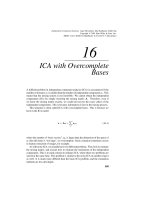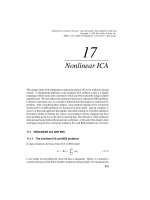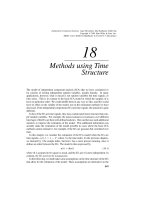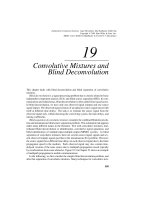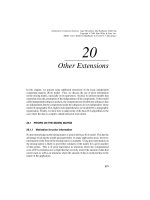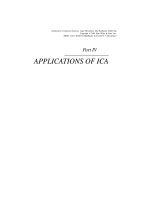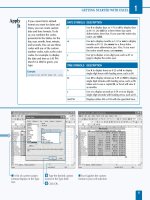Tài liệu Independent component analysis P14 ppt
Bạn đang xem bản rút gọn của tài liệu. Xem và tải ngay bản đầy đủ của tài liệu tại đây (300.05 KB, 17 trang )
14
Overview and Comparison
of Basic ICA Methods
In the preceding chapters, we introduced several different estimation principles and
algorithms for independent component analysis (ICA). In this chapter, we provide
an overview of these methods. First, we show that all these estimation principles
are intimately connected, and the main choices are between cumulant-based vs.
negentropy/likelihood-based estimation methods, and between one-unit vs. multi-
unit methods. In other words, one must choose the nonlinearity and the decorrelation
method. We discuss the choice of the nonlinearity from the viewpoint of statistical
theory. In practice, one must also choose the optimization method. We compare the
algorithms experimentally, and show that the main choice here is between on-line
(adaptive) gradient algorithms vs. fast batch fixed-point algorithms.
At the end of this chapter, we provide a short summary of the whole of Part II,
that is, of basic ICA estimation.
14.1 OBJECTIVE FUNCTIONS VS. ALGORITHMS
A distinction that has been used throughout this book is between the formulation of
the objective function, and the algorithm used to optimize it. One might express this
in the following “equation”:
ICA method objective function optimization algorithm
In the case of explicitly formulated objective functions, one can use any of the
classic optimizationmethods, for example, (stochastic) gradient methodsand Newton
273
Independent Component Analysis. Aapo Hyv
¨
arinen, Juha Karhunen, Erkki Oja
Copyright
2001 John Wiley & Sons, Inc.
ISBNs: 0-471-40540-X (Hardback); 0-471-22131-7 (Electronic)
274
OVERVIEW AND COMPARISON OF BASIC ICA METHODS
methods. In some cases, however, the algorithm and the estimation principle may be
difficult to separate.
The properties of the ICA method depend on both of the objective function and
the optimization algorithm. In particular:
the statistical properties (e.g., consistency, asymptotic variance, robustness) of
the ICA method depend on the choice of the objective function,
the algorithmic properties (e.g., convergence speed, memory requirements,
numerical stability) depend on the optimization algorithm.
Ideally, these two classes of properties are independent in the sense that different
optimization methods can be used to optimize a single objective function, and a
single optimization method can be used to optimize different objective functions. In
this section, we shall first treat the choice of the objective function, and then consider
optimization of the objective function.
14.2 CONNECTIONS BETWEEN ICA ESTIMATION PRINCIPLES
Earlier, we introduced several different statistical criteria for estimation of the ICA
model, including mutual information, likelihood, nongaussianity measures, cumu-
lants, and nonlinear principal component analysis (PCA) criteria. Each of these
criteria gave an objective function whose optimization enables ICA estimation. We
have already seen that some of them are closely connected; the purpose of this section
is to recapitulate these results. In fact, almost all of these estimation principles can be
considered as different versions of the same general criterion. After this, we discuss
the differences between the principles.
14.2.1 Similarities between estimation principles
Mutual information gives a convenient starting point for showing the similarity be-
tween different estimation principles. We have for an invertible linear transformation
:
(14.1)
If we constrain the to be uncorrelated and of unit variance, the last term on the
right-hand side is constant; the second term does not depend on anyway (see
Chapter 10). Recall that entropy is maximized by a gaussian distribution, when
variance is kept constant (Section 5.3). Thus we see that minimization of mutual
information means maximizing the sum of the nongaussianities of the estimated
components. If these entropies (or the corresponding negentropies) are approximated
by the approximations used in Chapter 8, we obtain the same algorithms as in that
chapter.
CONNECTIONS BETWEEN ICA ESTIMATION PRINCIPLES
275
Alternatively, we could approximate mutual information by approximating the
densities of the estimated ICs by some parametric family, and using the obtained
log-density approximations in the definition of entropy. Thus we obtain a method
that is essentially equivalent to maximum likelihood (ML) estimation.
The connections to other estimation principles can easily be seen using likelihood.
First of all, to see the connection to nonlinear decorrelation, it is enough to compare
the natural gradient methods for ML estimation shown in (9.17) with the nonlinear
decorrelation algorithm (12.11): they are of the same form. Thus, ML estimation
gives a principled method for choosing the nonlinearities in nonlinear decorrelation.
The nonlinearities used are determined as certain functions of the probability density
functions (pdf’s) of the independent components. Mutual information does the same
thing, of course, due to the equivalency discussed earlier. Likewise, the nonlin-
ear PCA methods were shown to be essentially equivalent to ML estimation (and,
therefore, most other methods) in Section 12.7.
The connection of the preceding principles to cumulant-based criteria can be seen
by considering the approximation of negentropy by cumulants as in Eq. (5.35):
kurt (14.2)
where the first term could be omitted, leaving just the term containing kurtosis.
Likewise, cumulants could be used to approximate mutual information, since mutual
information is based on entropy. More explicitly, we could consider the following
approximation of mutual information:
kurt (14.3)
where and are some constants. This shows clearly the connection between
cumulants and minimization of mutual information. Moreover, the tensorial methods
in Chapter 11 were seen to lead to the same fixed-point algorithm as the maximization
of nongaussianity as measured by kurtosis,which shows that they are doing very much
the same thing a s the other kurtosis-based methods.
14.2.2 Differences between estimation principles
There are, however, a couple of differences between the estimation principles as well.
1. Some principles (especially maximum nongaussianity) are able to estimate
single independent components, whereas others need to estimate all the com-
ponents at the same time.
2. Some objective functions use nonpolynomial functions based on the (assumed)
probability density functions of the independent components, whereas others
use polynomial functions related to cumulants. This leads to different non-
quadratic functions in the objective functions.
3. In many estimation principles, the estimates of the ICs are constrained to be
uncorrelated. This reduces somewhat the space in which the estimation is
276
OVERVIEW AND COMPARISON OF BASIC ICA METHODS
performed. Considering, for example, mutual information, there is no reason
why mutual information would be exactly minimized by a decomposition that
gives uncorrelated components. Thus, this decorrelation constraint slightly
reduces the theoretical performance of the estimation methods. In practice,
this may be negligible.
4. Oneimportant difference in practice is that often in ML estimation, the densities
of the ICs are fixed in advance, using prior knowledge on the independent
components. This is possible because the pdf’s of the ICs need not be known
with any great precision: in fact, it is enough to estimate whether they are sub-
or supergaussian. Nevertheless, if the prior information on the nature of the
independent components is not correct, ML estimation will give completely
wrong results, as was shown in Chapter 9. Some care must be taken with ML
estimation, therefore. In contrast, using approximations of negentropy, this
problem does not usually arise, since the approximations we have used in this
book do not depend on reasonable approximations of the densities. Therefore,
these approximations are less problematic to use.
14.3 STATISTICALLY OPTIMAL NONLINEARITIES
Thus, from a statistical viewpoint, the choice of estimation method is more or less
reduced to the choice of the nonquadratic function that gives information on the
higher-order statistics in the form of the expectation . In the algorithms,
this choice corresponds to the choice of the nonlinearity that is the derivative of .
In this section, we analyze the statistical properties of different nonlinearities. This
is based on the family of approximations of negentropy given in (8.25). This family
includes kurtosis as well. For simplicity, we consider here the estimation of just one
IC, given by maximizing this nongaussianity measure. This is essentially equivalent
to the problem
(14.4)
where the sign of depends of the estimate o n the sub- or supergaussianity of .
The obtained vector is denoted by . The two fundamental statistical properties of
that we analyze are asymptotic variance and robustness.
14.3.1 Comparison of asymptotic variance *
In practice, one usually has only a finite sample of observations of the vector .
Therefore, the expectations in the theoretical definition of the objective function are in
fact replaced by sample averages. This results in certain errors in the estimator ,and
it is desired to make these errors as small as possible. A classic measure of this error
is asymptotic (co)variance, which means the limit of the covariance matrix of as
. This gives an approximation of the mean-square error of , as was already
STATISTICALLY OPTIMAL NONLINEARITIES
277
discussed in Chapter 4. Comparison of, say, the traces of the asymptotic variances of
two estimators enables direct comparison of the accuracy of two estimators. One can
solve analytically for the asymptotic variance of
, obtaining the following theorem
[193]:
Theorem 14.1 The trace of the asymptotic variance of
as defined above for the
estimation of the independent component , equals
(14.5)
where
is the derivative of , and is a constant that depends only on .
The theorem is proven at the appendix of this chapter.
Thus the comparison of the asymptotic variances of two estimators for two different
nonquadratic functions boils down to a comparison of the . In particular, one
can use variational calculus to find a that minimizes . Thus one obtains the
following theorem [193]:
Theorem 14.2 The trace of the asymptotic variance of is minimized when is of
the form
(14.6)
where is the density fu nction of , and are arbitrary constants.
For simplicity, one can choose . Thus, we see that the optimal
nonlinearity is in fact the one used in the definition of negentropy. This shows that
negentropy is the optimal measure of nongaussianity, at least inside those measures
that lead to estimators of the form considered here.
1
Also, one sees that the optimal
function is the same as the one obtained for several units by the maximum likelihood
approach.
14.3.2 Comparison of robustness *
Another very desirable property of an estimator is robustness against outliers. This
means that single, highly erroneous observations do not have much influence on the
estimator. In this section, we shall treat the question: How does the robustness of
the estimator depend on the choice of the function ? The main result is that the
function should not grow fast as a function of if we want robust estimators.
In particular, this means that kurtosis gives nonrobust estimators, which may be very
disadvantagous in some situations.
1
One has to take into account, however, that in the definition of negentropy, the nonquadratic function is
not fixed in advance, whereas in our nongaussianity measures, is fixed. Thus, the statistical properties
of negentropy can be only approximatively derived from our analysis.
278
OVERVIEW AND COMPARISON OF BASIC ICA METHODS
First, note that the robustness of depends also on the method of estimation used
in constraining the variance of to equal unity, or, equivalently, the whitening
method. This is a problem independent of the choice of . In the following, we
assume that this constraint is implemented in a robust way. In particular, we assume
that the data is sphered (whitened) in a robust manner, in which case the constraint
reduces to ,where is the value of for whitened data. Several robust
estimators of the variance of or of the covariance matrix of are presented in
the literature; see reference [163].
The robustness of the estimator can be analyzed using the theory of M-
estimators. Without going into technical details, the definition of an M-estimator
can be formulated as follows: an estimator is called an M-estimator if it is defined as
the solution for of
(14.7)
where is a random vector and is some function d efining the estimator. Now, the
point is that the estimator is an M-estimator. To see this, define ,where
is the Lagrangian multiplier associated with the constraint. Using the Lagrange
conditions, the estimator can then be formulated as the solution of Eq. (14.7) where
is defined as follows (for sphered data):
(14.8)
where is an irrelevant constant.
The analysis of robustness of an M-estimator is based on the concept of an
influence function, . Intuitively speaking, the influence function measures
the influence of single observations on the estimator. It would be desirable to have
an influence function that is bounded as a function of ,asthisimpliesthateven
the influence of a far-away outlier is “bounded”, and cannot change the estimate
too much. This requirement leads to one definition of robustness, which is called
B-robustness. An estimator is called B-robust, if its influence function is bounded
as a function of , i.e., is finite for every . Even if the influence
function is not bounded, it should grow as slowly as possible when grows, to
reduce the distorting effect of outliers.
It can be shown that the influence function of an M-estimator equals
(14.9)
where is an irrelevant invertible matrix that does not depend on . On the other
hand, using our definition of , and denoting by the cosine of the
angle between and , one obtains easily
(14.10)
where are constants that do not depend on ,and . Thus we
see that the robustness of essentially depends on the behavior of the function .
STATISTICALLY OPTIMAL NONLINEARITIES
279
The slower grows, the more robust the estimator. However, the estimator really
cannot be B-robust, because the in the denominator prevents the influence function
from being bounded for all . In particular, outliers that are almost orthogonal to ,
and have large norms, may still have a large influence on the estimator. These results
are stated in the following theorem:
Theorem 14.3 Assume that the data is whitened (sphered) in a robust manner.
Then the influence function of the estimator is never bounded for all . However,
if is bounded, the influence function is bounded in sets of the form
for every ,where is the derivative of .
In particular, if one chooses a function that is bounded, is also bounded,
and is quite robust against outliers. If this is not possible, one should at least choose
a function that does not grow very fast when grows. If, in contrast,
grows very fast when grows, the estimates depend mostly on a few observations far
from the origin. This leads to highly nonrobust estimators, which can be completely
ruined by just a couple of bad outliers. This is the case, for example, when kurtosis
is used, which is equivalent to using with .
14.3.3 Practical choice of nonlinearity
It is useful to analyze the implications of the preceding theoretical results by consid-
ering the following family of density functions:
(14.11)
where is a positive constant, and are normalization constants that ensure
that is a probability density of unit variance. For different values of alpha, the
densities in this family exhibit different shapes. For , one obtains a sparse,
supergaussian density (i.e., a density of positive kurtosis). For , one obtains the
gaussian distribution, and for , a subgaussian density (i.e., a density of negative
kurtosis). Thus the densities in this family can be used as examples of different
nongaussian densities.
Using Theorem 14.1, one sees that in terms of asymptotic variance, the optimal
nonquadratic function is of the form:
(14.12)
where the arbitrary constants have been dropped for simplicity. This implies roughly
that for supergaussian (resp. subgaussian) densities, the optimal function is a function
that grows slower than quadratically (resp. faster than quadratically). Next, recall
from Section 14.3.2 that if grows fast with , the estimator becomes highly
nonrobust against outliers. Also taking into account the fact that most ICs encountered
in practice are supergaussian, one reaches the conclusion that as a general-purpose
function, one should choose a function that resembles rather
where (14.13)
280
OVERVIEW AND COMPARISON OF BASIC ICA METHODS
The problem with such functions is, however, that they are not differentiable at for
. This can lead to problems in the numerical optimization. Thus it is better
to use approximating differentiable functions that have the same kind of qualitative
behavior. Considering , in which case one has a Laplacian density, one could
use instead the function where is a constant. This is very
similar to the so-called Huber function that is widely u sed in robust statistics as
a robust alternative of the square function. Note that the derivative of is then
the familiar function (for ). We have found to provide
a good approximation. Note that there is a trade-off between the precision of the
approximation and the s moothness of the resulting objective function.
In the case of , i.e., highly supergaussian ICs, one could approximate
the behavior o f for large using a gaussian function (with a minus sign):
. The derivative of this function is like a sigmoid for small
values, but goes to
for larger values. Note that this function also fulfills the
condition in Theorem 14.3, thus providing an estimator that is as robust as possible
in this framework.
Thus, we reach the following general conclusions:
A good general-purpose function is ,where
is a constant.
When the ICs are highly supergaussian, or when robustness is very important,
may be better.
Using kurtosis is well justified only if the ICs are subgaussian and there are no
outliers.
In fact, these two nonpolynomial functions are those that we used in the nongaus-
sianity measures in Chapter 8 as well, and illustrated in Fig. 8.20. The functions in
Chapter 9 are also essentially the same, since addition of a linear function does not
have much influence on the estimator. Thus, the analysis of this section justifies the
use of the nonpolynomial functions that we used previously, and shows why caution
should b e taken when using kurtosis.
In this section, we have used purely statistical criteria for choosing the function .
One important criterion for comparing ICA methods that is completely independent
of statistical considerations is the computational load. Since most of the objective
functions are computationally very similar, the computational load is essentially a
function o f the optimization algorithm. The choice of the optimization algorithm
will be considered in the next section.
14.4 EXPERIMENTAL COMPARISON OF ICA ALGORITHMS
The theoretical analysis of the preceding section gives some guidelines as to which
nonlinearity (corresponding to a nonquadratic function ) should be chosen. In
this section, we compare the ICA algorithms experimentally. Thus we are able to
EXPERIMENTAL COMPARISON OF ICA ALGORITHMS
281
analyze the computational efficiency of the different algorithms as well. This is done
by experiments, since a satisfactory theoretical analysis of convergence speed does
not seem possible. We saw previously, though, that FastICA has quadratic or cubic
convergencewhereas gradient methods have only linear convergence, but this result is
somewhat theoretical because it does not say anything about the global convergence.
In the same experiments, we validate experimentally the earlier analysis of statistical
performance in terms of asymptotic variance.
14.4.1 Experimental set-up and algorithms
Experimental setup
In the following experimental comparisons, artificial data
generated from known sources was used. This is quite necessary, because only then
are the correct results known and a reliable comparison possible. The experimental
setup was the same for each algorithm in order to make the comparison as fair as
possible. We have also compared various ICA algorithms using real-world data in
[147], where experiments with artificial data also are described in somewhat more
detail. At the end of this section, conclusions from experiments with real-world data
are presented.
The algorithms were compared along the two sets of criteria, statistical and com-
putational, as was outlined in Section 14.1. The computational load was measured
as flops (basic floating-point operations, such as additions or divisions) needed for
convergence. The statistical performance, or accuracy, was measured using a perfor-
mance index, defined as
(14.14)
where is the th element of the matrix . If the ICs have been
separated perfectly, becomes a permutation matrix (where the elements may have
different signs, though). A permutation matrix is defined so that on each of its rows
and columns, only one of the elements is equal to unity while all the other elements
are zero. Clearly, the index (14.14) attains its minimum value zero for an ideal
permutation matrix. The larger the value is, the poorer the statistical performance
of a separation algorithm. In certain experiments, another fairly similarly behaving
performance index, , was used. It differs slightly from in that squared values
are used instead of the absolute ones in (14.14).
ICA algorithms used
The following algorithms were included in the comparison
(their abbreviations are in parentheses):
The FastICA fixed-point algorithm. This has three variations: using kurtosis
with deflation (FP) or with symmetric orthogonalization (FPsym), and using
the nonlinearity with symmetric orthogonalization (FPsymth).
Gradient algorithms for maximum likelihood estimation, using a fixed nonlin-
earity given by . First, we have the ordinary gradient ascent algorithm,
282
OVERVIEW AND COMPARISON OF BASIC ICA METHODS
or the Bell-Sejnowski algorithm (BS). Second, we have the natural gradient
algorithm proposed by Amari, Cichocki and Yang [12], which is abbreviated
as ACY.
Natural gradient MLE using an adaptive nonlinearity. (Abbreviated as ExtBS,
since this is called the “extended Bell-Sejnowski” algorithm by some authors.)
The nonlinearity was adapted using the sign of kurtosis as in reference [149],
which is essentially equivalent to the density parameterization we used in
Section 9.1.2.
The EASI algorithm for nonlinear decorrelation, as discussed in Section 12.5.
Again, the nonlinearity used was .
The recursive least-squares algorithm for a nonlinear PCA criterion (NPCA-
RLS), discussed in Section 12.8.3. In this algorithm, the plain function
could not be used for stability reasons, but a slightly modified nonlinearity was
chosen: .
Tensorial algorithms were excluded from this comparison due to the problems of
scalability discussed in Chapter 11. Some tensorial algorithms have been compared
rather thoroughly in [315]. However, the conclusions are of limited value, because
the data used in [315] always consisted of the same three subgaussian ICs.
14.4.2 Results for simulated data
Statistical performance and computational load
The basic experiment
measures the computational load and statistical performance (accuracy) of the tested
algorithms. We performed experiments with 10 independent components that were
chosen supergaussian, because for this source type all the algorithms in the com-
parison worked, including ML estimation with a fixed nonlinearity. The
mixing matrix used in our simulations consisted of uniformly distributed random
numbers. For achieving statistical reliability, the experiment was repeated over 100
different realizations of the input data. For each of the 100 realizations, the accuracy
was measured using the error index . The computational load was measured in
floating point operations needed for convergence.
Fig. 14.1 shows a schematic diagram of the computational load vs. the statistical
performance. The boxes typically contain 80% of the 100 trials, thus representing
standard outcomes.
As for statistical performance, Fig. 14.1 shows that best results are obtained by
using a nonlinearity (with the right sign). This was to be expected according
to the theoretical analysis of Section 14.3. tanh is a good nonlinearity especially
for supergaussian ICs as in this experiment. The kurtosis-based FastICA is clearly
inferior, especially in the deflationary version. Note that the statistical performance
only depends on the nonlinearity, and not on the optimization method, as explained
in Section 14.1. All the algorithms using have pretty much the same statistical
performance. Note also that no outliers were added to the data, so the robustness of
the algorithms is not measured here.
EXPERIMENTAL COMPARISON OF ICA ALGORITHMS
283
10
6
10
7
10
8
10
9
2
3
4
5
6
7
8
9
10
FP
FPsym
FPsymth
ExtBS
Flops
Error index E
1
NPCA−RLS
ACY
BS
EASI
Fig. 14.1
Computational requirements in flops versus the statistical error index .
(Reprinted from [147], reprint permission and copyright by World Scientific, Singapore.)
Looking at the computational load, one sees clearly that FastICA requires the
smallest amount of computation. Of the on-line algorithms, NPCA-RLS converges
fastest, probably due to its roughly optimal determination of learning parameters. For
the other on-line algorithms, the learning parameter was a constant, determined by
making some preliminary experiments so that a value providing good convergence
was found. These ordinary gradient-type algorithms have a computational load that
is about 20–50 times larger than for FastICA.
To conclude, the best results from a statistical viewpoint are obtained when using
the nonlinearity with any algorithm. (Some algorithms, especially the tensorial
ones, cannot use the nonlinearity, but these were excluded from this comparison
for reasons discussed earlier.) As for the computational load, the experiments show
that the FastICA algorithm is much faster than the gradient algorithms.
Convergence speed of on-line algorithms
Next, we studied the convergence
speeds of the on-line algorithms. Fixed-point algorithms do not appear in this com-
parison, because they are of a different type and a direct comparison is not possible.
284
OVERVIEW AND COMPARISON OF BASIC ICA METHODS
0 0.5 1 1.5 2 2.5 3
x 10
8
0
10
20
30
40
50
60
70
80
90
Flops
Error index E
1
ACY
BS
NPCA−RLS
EASI
Fig. 14.2
Convergence speed of on-line ICA algorithms as a function of required floating-
point operations for 10 supergaussian ICs. (Reprinted from [147], reprint permission and
copyright by World Scientific, Singapore.)
The results (shown in Fig. 14.2) are averages of 10 trials for 10 supergaussian ICs
(for which all the algorithms worked without on-line estimation of kurtosis). The
main observation is that the recursive least-squares version of the nonlinear PCA al-
gorithm (NPCA-RLS) is clearly the fastest converging of the on-line algorithms. The
difference between NPCA-RLS and the other algorithms could probably be reduced
by using simulated annealing or other more sophisticated technique for determining
the learning parameters.
For subgaussian ICs, the results were qualitatively similar to those in Fig. 14.2,
except that sometimes the EASI algorithm may converge even faster than NPCA-RLS.
However, sometimes its convergence speed was the poorest among the compared
algorithms. Generally, a weakness of on-line algorithms using stochastic gradients
is that they are fairly sensitive to the choice of the learning parameters.
EXPERIMENTAL COMPARISON OF ICA ALGORITHMS
285
0 2 4 6 8 10 12 14
0
0.1
0.2
0.3
0.4
0.5
0.6
0.7
0.8
0.9
Number of sources
Error index E
2
1/2
FP
FPsymth
NPCA−RLS
ACY
EASI
ExtBS
Fig. 14.3
Error as a function of the number of ICs. (Reprinted from [147], reprint permission
and copyright by World Scientific, Singapore.)
Error for increasing number of components
We also made a short investi-
gation on how the statistical performances of the algorithms change with increasing
number of components. In Fig. 14.3, the error (square root of the error index )is
plotted as the function of the number of supergaussian ICs. The results are median
values over 50 different realizations of the input data. For more than five ICs, the
number of data samples was increased so that it was proportional to the square of
the number of ICs. The natural gradient ML algorithm (ACY), and its version with
adaptive nonlinearity (ExtBS), achieve some of the best accuracies, behaving very
similarly. The basic fixed-point algorithm (FP) using a cubic nonlinearity has the
poorest accuracy, but its error increases only slightly after seven ICs. On the other
hand, the version of the fixed-point algorithm which uses symmetric orthogonaliza-
tion and nonlinearity (FPsymth) performs as well as the natural gradient ML
algorithm. Again, we see that it is the nonlinearity that is the most important in
determining statistical performance. For an unknown reason, the errors of the EASI
and NPCA-RLS algorithms have a peak around 5–6 ICs. For a larger number of
ICs, the accuracy of the NPCA-RLS algorithm is close to the best algorithms, while
286
OVERVIEW AND COMPARISON OF BASIC ICA METHODS
the error of EASI increases linearly with the number of independent components.
However, the error of all the algorithms is tolerable for most practical purposes.
Effect of noise
In [147], the effect of additive gaussian noise on the performance
of ICA algorithms has been studied, too. The first conclusion is that the estimation
accuracy degrades fairly smoothly until the noise power increases up to dB of
the signal power. If the amount of noise is increased even more, it may happen that
the studied ICA algorithms are not able to separate all the sources. In practice, noise
smears the separated ICs or sources, making the separation results almost useless if
there is a lot of noise present.
Another observation is that once there is even a little noise present in the data,
the error strongly depends on the condition number of the mixing matrix .The
condition number of a matrix [320, 169] describes how close to singularity it is.
14.4.3 Comparisons with real-world data
We have compared in [147] the preceding ICA algorithms using three different
real-world data sets. The applications were projection pursuit for well-known crab
and satellite data sets, and finding interesting source signals from the biomedical
magnetoencephalographic data (see Chapter 22). For the real-world data, the true
independent components are unknown, and the assumptions made in the standard
ICA model may not hold, or hold only approximately. Hence it is only possible to
compare the performances of the ICA algorithms with each other, in the application
at hand.
The following general conclusions can be made from these experiments [147]:
1. ICA is a robust technique. Even though the assumption of statistical indepen-
dence is not strictly fulfilled, the algorithms converge towards a clear set of
components (MEG data), or a subspace of components whose dimension is
much smaller than the dimension of the problem (satellite data). This is a good
characteristic encouraging the use of ICA as a general data analysis tool.
2. The FastICA algorithm and the natural gradient ML algorithm with adaptive
nonlinearity (ExtBS) yielded usually similar results with real-world data. This
is not surprising, because there exists a close theoretical connection between
these algorithms, as discussed in Chapter 9. Another pair of similarly behaving
algorithms consisted of the EASI algorithm and the nonlinear PCA algorithm
using recursive least-squares (NPCA-RLS).
3. In difficult real-world problems, it is useful to apply several different ICA
algorithms, because they may reveal different ICs from the data. For the MEG
data, none of the compared algorithms was best in separating all types of source
signals.
REFERENCES
287
14.5 REFERENCES
The fundamental connection between cumulants and negentropy and mutual infor-
mation was introduced in [89]. A similar approximation of likelihood by cumulants
was introduced in [140]. Approximation of negentropy by cumulants was originally
considered in [222]. The connection between infomax and likelihood was shown
in [363, 64], and the connection between mutual information and likelihood has
been explicitly discussed in [69]. The interpretation of nonlinear PCA criteria as
maximum likelihood estimation was presented in [236]. The connections between
different methods were discussed in such review papers as [201, 65, 269].
The theoretical analysis of the performance of the estimators is taken from [193].
See [69] for more information, especially on the effect of the decorrelation constraint
on the estimator. On robustness and influence functions, see such classic texts as
[163, 188].
More details on the experimental comparison can be found in [147].
14.6 SUMMARY OF BASIC ICA
Now we summarize Part II. This part treated the estimation of the basic ICA model,
i.e., the simplified model with no noise or time-structure, and a square mixing
matrix. The observed data is modeled as a linear transformation
of components that are statistically independent:
(14.15)
This is a rather well-understood problem for which several approaches have been
proposed. What distinguished ICA from PCA and classic factor analysis is that the
nongaussian structure of the data is taken into account. This higher-order statistical
information (i.e., information not contained in the mean and the covariance matrix)
can be utilized, and therefore, the independent components can be actually separated,
which is not possible by PCA and classic factor analysis.
Often, the data is preprocessed by whitening (sphering), which exhausts the second
order information that is contained in the covariance matrix, and makes it easier to
use the higher-order information:
(14.16)
The linear transformation in the model is then reduced to an orthogonal one,
i.e., a rotation. Thus, we are searching for an orthogonal matrix so that
should be good estimates of the independent components.
Several approaches can then be taken to utilize the higher-order information. A
principled, yet intuitive approach is given by finding linear combinations of maximum
nongaussianity, as motivated by the central limit theorem. Sums of nongaussian
random variables tend to be closer to gaussian that the original ones. Therefore if
we take a linear combination of the observed (whitened) variables,
288
OVERVIEW AND COMPARISON OF BASIC ICA METHODS
this will be maximally nongaussian if it equals one of the independent components.
Nongaussianity can be measured by kurtosis or by (approximations of) negentropy.
This principle shows the very close connection between ICA and projection pursuit,
in which the most nongaussian projections are considered as the interesting ones.
Classic estimation theory directly gives another method for ICA estimation: max-
imum likelihood estimation. An information-theoretic alternative is to minimize the
mutual information of the components. All these principles are essentially equiva-
lent or at least closely related. The principle of maximum nongaussianity has the
additional advantage of showing how to estimate the independent components one-
by-one. This is possible by a deflationary orthogonalization of the estimates of the
individual independent components.
With every estimation method, we are optimizing functions of expectations of
nonquadratic functions, which is necessary to gain access to higher-order informa-
tion. Nonquadratic functions usually cannot be maximized simply by solving the
equations: Sophisticated numerical algorithms are necessary.
The choice of the ICA algorithm is basically a choice between on-line and batch-
mode algorithms. In the on-line case, the algorithms are obtained by stochastic
gradient methods. If all the independent components are estimated in parallel, the
most popular algorithm in this category is natural gradient ascent of likelihood.The
fundamental equation in this method is
(14.17)
where the component-wise nonlinear function is determined from the log-densities
of the independent components; see Table 9.1 for details.
In the more usual case, where the computations are made in batch-mode (off-
line), much more efficient algorithms are available. The FastICA algorithm is a very
efficient batch algorithm that can be derived either from a fixed-point iteration or as
an approximate Newton method. The fundamental iteration in FastICA is, for one
row of :
(14.18)
where the nonlinearity can be almost any smooth function, and should be
normalized to unit norm at every iteration. FastICA can be used to estimate the
components either one-by-one by finding maximally nongaussian directions (see
Tables 8.3), or in parallel by maximizing nongaussianity or likelihood (see Table 8.4
or Table 9.2).
In practice, before application of these algorithms, suitable preprocessing is often
necessary (Chapter 13). In addition to the compulsory centering and whitening, it is
often advisable to perform principal component analysis to reduce the dimension o f
the data, or some time filtering by taking moving averages.
APPENDIX
289
Appendix Proofs
Here we pro ve Theorem 14.1. Making the change of variable , the equation defining
the optimal solutions
becomes
(A.1)
where
is the sample index, is the sample size, and is a Lagrangian multiplier
Without loss of generality, let us assume that
is near the ideal solution .Note
that due to the constraint
, the variance of the first c omponent of ,
denoted by
, is of a smaller order than the v ariance of the vector of other components, denoted
by
. Excluding the first component in (A.1), and making the first-order approximation
,wherealso denotes without its first component, one
obtains after some simple manipulations
(A.2)
where the sample index
has been dropped for simplicity. Making the first-order approximation
, one can write (A.2) in the form where conv er ges to the
identity matrix multiplied by
,and converges to a variable that
has a normal distribution of zero mean whose covariance matrix equals the identity matrix
multiplied by
. This implies the theorem, since ,
where
is the inverse of without its first row.

